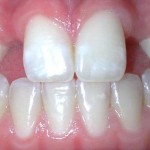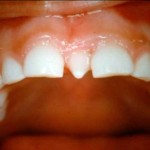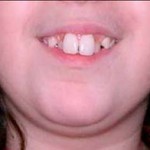 1)Â Â Â Â Â HYPODONTIA :
1)Â Â Â Â Â HYPODONTIA :
A dental condition where by the patient has missing teeth as a result of their failure of development. The most common missing tooth is the third molars, or known as wisdom tooth.  Hypodontia can be due to genetic or environmental factors.  It is been reported in association with low birth weight, increased maternal age and etc.
There are few medical conditions which are related to hypodontia:
i)Â Â Â Â Â Â Â Â Â Â Â Â Â Â Â Â Â Â Â Hypohidrotic ectodermal dysplasia (a medical condition which involves the ectodermal structures such as hair, teeth, nail, skin. Clinical features include thin sparse hair, dry skin, absence of sweating and multiple missing teeth.
ii)                  Clefting . Cleft patients are most likely to have missing lateral incisor  or an extra supernumerary tooth at the cleft region.
iii)Â Â Â Â Â Â Â Â Â Â Â Â Â Â Â Â Down syndrome
Treatment for hypodontia patients:
1)Â Â Â Â Â Partial dentures /full dentures to replace missing teeth.
2)Â Â Â Â Â Perform oral surgery to expose the impacted tooth.
3)Â Â Â Â Â Orthodontic appliance to achieve space closure.
4)Â Â Â Â Â Dental bridges, implants can be placed to replace the missing tooth.
 2)Â Â Â Â Â SUPERNUMERARY TOOTH:
2)Â Â Â Â Â SUPERNUMERARY TOOTH:
a dental condition when you have more than the normal number of teeth. Supernumerary tooth can resemble the shape of the incisor, canine or molar. It has the tendency to occur more among males. Teeth which resemble the shape of normal teeth is referred as supplemental teeth while those which do not resemble the shape of normal teeth is termed as accessory supernumerary tooth.  They are often associated with an erupted permanent tooth. The best treatment option for supernumerary tooth  is to extract the supernumerary tooth to allow the eruption of the permanent tooth.
refers to any tooth or teeth which are larger than normal for that particular type of tooth. The cause of macrodontia is unknown and is most probably due to hormonal imbalance and certain medical conditions. Macrodontia can be localized (affecting only few teeth) or generalized (affecting the entire dentition) Generalized hypodontia is often associated with gigantism.
What we can do to manage patients with macrodontia:
Dental practitioner can perform proximal stripping to reduce the size of the large tooth/teeth. However, the outcome is to a certain extent.
Extraction and placement of prosthesis  can be done if patient is really concerned about the abnormal size of his tooth.
Microdontia is a dental condition where patient has tooth or teeth which are smaller than normal for that particular type of tooth. Females are more often affected than males, with the maxillary lateral incisor being most commonly affected. Microdontia can be also associated with hypodontia in certain conditions. Composite build up/ dental veneers are usually placed to increase the size and improve the shape of the tooth.
5)Â Â Â Â Â Dens invaginatus and evaginatus
Â
Dens evaginatus is also known as the talon cusp. A small tubercle will be projected out from the occlusal surface of the tooth, affecting primarily the premolar tooth. There is a risk of pulpal exposure and pulp necrosis because the tubercle can be worn and fractured off by normal wear.
Management of dens evaginatus:
1) Placement of fissure sealant to protect the occlusal surface and to prevent pulp exposure.
2) Placement of composite and recontour the occlusal surface.
3) Perform Selective grinding to promote reactionary dentine deposition on the pulpal surface.
4) Removal of tubercle and perform pulpotomy on that particular tooth. Pulpotomy is a procedure where by the inflamed tissues of the primary tooth is removed and sealed with a medicated filling material.
Dens invaginatus is a dental condition whereby the outer surface of the tooth is fold inwards, leaving a thin layer of hard tissue barrier between the pulp and oral cavity. Problems often associated with dens invaginatus are dental caries and pulpal involvement. Similar to dens evaginatus, fissure sealant and dental composite can be placed to protect the occlusal surface. If pulp necrosis occurs before your root formation is completed, apexification should be performed in order to save the tooth.
Â
Â
Â

